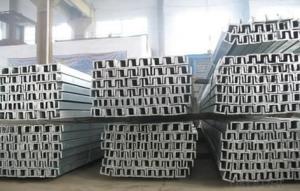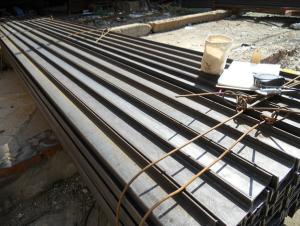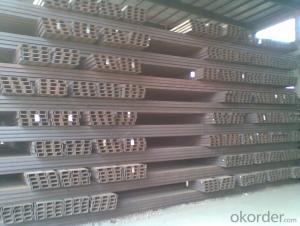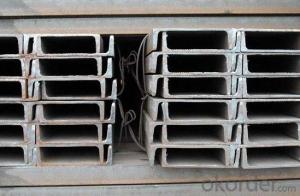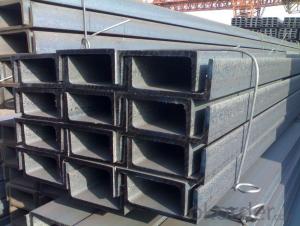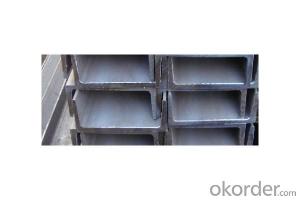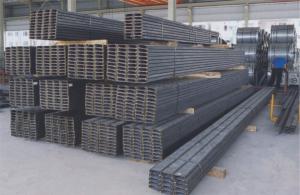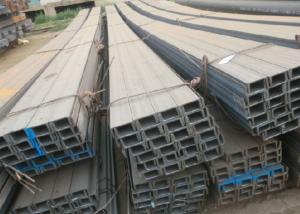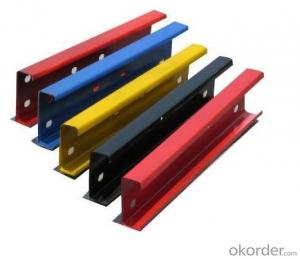Hot Rolled Steel Channel 150mm
- Loading Port:
- China Main Port
- Payment Terms:
- TT or LC
- Min Order Qty:
- -
- Supply Capability:
- -
OKorder Service Pledge
OKorder Financial Service
You Might Also Like
Product Description:
OKorder is offering Hot Rolled Steel Channel 150mm at great prices with worldwide shipping. Our supplier is a world-class manufacturer of steel, with our products utilized the world over. OKorder annually supplies products to European, North American and Asian markets. We provide quotations within 24 hours of receiving an inquiry and guarantee competitive prices.
Product Applications:
Hot Rolled Steel Channel 150mm are ideal for structural applications and are widely used in the construction of buildings and bridges, and the manufacturing, petrochemical, and transportation industries.
Product Advantages:
OKorder's Hot Rolled Steel Channel 150mm are durable, strong, and resist corrosion.
Main Product Features:
· Premium quality
· Prompt delivery & seaworthy packing (30 days after receiving deposit)
· Corrosion resistance
· Can be recycled and reused
· Mill test certification
· Professional Service
· Competitive pricing
Product Specifications:
Manufacture: Hot rolled
Grade: Q195 – 235
Certificates: ISO, SGS, BV, CIQ
Length: 6m – 12m, as per customer request
Packaging: Export packing, nude packing, bundled
Chinese Standard (H*W*T) | Weight (Kg/m) | 6m (pcs/ton) | Light I (H*W*T) | Weight (Kg/m) | 6m (pcs/ton) | Light II (H*W*T) | Weight (Kg/m) | 6M |
100*68*4.5 | 11.261 | 14.8 | 100*66*4.3 | 10.13 | 16.4 | 100*64*4 | 8.45 | 19.7 |
120*74*5.0 | 13.987 | 11.9 | 120*72*4.8 | 12.59 | 13.2 | 120*70*4.5 | 10.49 | 15.8 |
140*80*5.5 | 16.89 | 9.8 | 140*78*5.3 | 15.2 | 10.9 | 140*76*5 | 12.67 | 13.1 |
160*88*6 | 20.513 | 8.1 | 160*86*5.8 | 18.46 | 9 | 160*84*5.5 | 15.38 | 10.8 |
180*94*6.5 | 24.143 | 6.9 | 180*92*6.3 | 21.73 | 7.6 | 180*90*6 | 18.11 | 9.2 |
200*100*7 | 27.929 | 5.9 | 200*98*6.8 | 25.14 | 6.6 | 200*96*6.5 | 20.95 | 7.9 |
220*110*7.5 | 33.07 | 5 | 220*108*7.3 | 29.76 | 5.6 | 220*106*7 | 24.8 | 6.7 |
250*116*8 | 38.105 | 4.3 | 250*114*7.8 | 34.29 | 4.8 | 250*112*7.5 | 28.58 | 5.8 |
280*122*8.5 | 43.492 | 3.8 | 280*120*8.2 | 39.14 | 4.2 | 280*120*8 | 36.97 | 4.5 |
300*126*9 | 48.084 | 3.4 | 300*124*9.2 | 43.28 | 3.8 | 300*124*8.5 | 40.87 | 4 |
320*130*9.5 | 52.717 | 3.1 | 320*127*9.2 | 48.5 | 3.4 | |||
360*136*10 | 60.037 | 2.7 | 360*132*9.5 | 55.23 | 3 |
FAQ:
Q1: Why buy Materials & Equipment from OKorder.com?
A1: All products offered byOKorder.com are carefully selected from China's most reliable manufacturing enterprises. Through its ISO certifications, OKorder.com adheres to the highest standards and a commitment to supply chain safety and customer satisfaction.
Q2: How do we guarantee the quality of our products?
A2: We have established an advanced quality management system which conducts strict quality tests at every step, from raw materials to the final product. At the same time, we provide extensive follow-up service assurances as required.
Q3: How soon can we receive the product after purchase?
A3: Within three days of placing an order, we will begin production. The specific shipping date is dependent upon international and government factors, but is typically 7 to 10 workdays.
Q4: What makes stainless steel stainless?
A4: Stainless steel must contain at least 10.5 % chromium. It is this element that reacts with the oxygen in the air to form a complex chrome-oxide surface layer that is invisible but strong enough to prevent further oxygen from "staining" (rusting) the surface. Higher levels of chromium and the addition of other alloying elements such as nickel and molybdenum enhance this surface layer and improve the corrosion resistance of the stainless material.
Q5: Can stainless steel rust?
A5: Stainless does not "rust" as you think of regular steel rusting with a red oxide on the surface that flakes off. If you see red rust it is probably due to some iron particles that have contaminated the surface of the stainless steel and it is these iron particles that are rusting. Look at the source of the rusting and see if you can remove it from the surface.
Images:
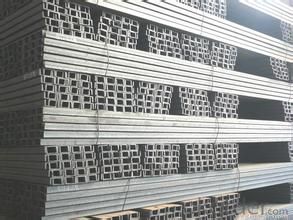
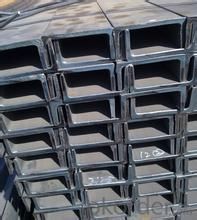
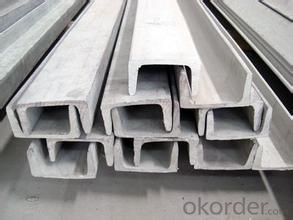
- Q: What is the maximum load-bearing capacity of channel 12M span 100?
- Suppose that the ends are hinged (other forms may be alternative), according to the mechanics of materialsBending moment M = 1/4PL = 18917.5Nm; P=56752N=56.8kNThe safety factor is taken as 1, and if the other is taken, the carrying capacity P is correspondingly reduced.
- Q: How do steel channels compare to other types of steel profiles?
- Steel channels are a specific type of steel profile that offers several advantages when compared to other types of steel profiles. Firstly, steel channels are known for their high strength and durability. The U-shaped design of steel channels allows them to support heavy loads and resist bending or warping, making them ideal for structural applications. This strength also helps them withstand extreme weather conditions and other external forces, ensuring their longevity. Secondly, steel channels have excellent versatility. They can be easily customized and fabricated to meet specific project requirements. This flexibility allows for various applications, including structural support, framing, and reinforcement. Steel channels also come in a range of sizes and thicknesses, making them suitable for projects of different scales. Furthermore, steel channels exhibit high corrosion resistance. They are commonly made from carbon or stainless steel, both of which have natural anti-corrosion properties. This makes steel channels suitable for outdoor and marine environments where exposure to moisture or chemicals is prevalent. Additionally, steel channels are cost-effective. Steel is a widely available and abundant material, making it relatively affordable compared to other construction materials. Moreover, the durability and longevity of steel channels result in reduced maintenance costs over time, making them a cost-efficient choice for many applications. Lastly, steel channels offer ease of installation. Their uniform shape and standardized dimensions make them simple to work with, reducing installation time and labor costs. This ease of installation also makes steel channels a preferred choice for DIY projects or small-scale constructions. In conclusion, steel channels have several advantages over other types of steel profiles. Their strength, versatility, corrosion resistance, cost-effectiveness, and ease of installation make them a popular choice for a variety of construction projects.
- Q: A solar roof concrete foundation steel embedded parts, steel embedded parts are welded on the welding channel, two channel to head to head up, ask whether the welding part of a steel plate welding lining need? Or what other requirements? What norms do these requirements come from? Thank you
- Steel mosaic, can be spliced according to the below methods: adopt web side welding stiffened plate (installed in the groove of the inner channel of the stiffened plate, flange plate groove) by sealing welding, welding seam groove cutting and slag inclusions shall be clean; check inspection after welding. The web stiffener is greater than or equal to the thickness of the web. The dimension of the reinforcing plate is: the length of the steel plate is equal to the height of the section steel, and the width is equal to the height of the section steel, minus 70mm.
- Q: How are steel channels used in the automotive industry?
- Various applications in the automotive industry commonly make use of steel channels. The structural framework of vehicles heavily relies on steel channels, which provide the necessary strength and rigidity for the chassis, ensuring the overall integrity of the vehicle's structure. These channels are particularly utilized in areas that require high load-bearing capabilities, such as the frame rails, cross members, and suspension components. Steel channels also serve the purpose of reinforcing body panels and doors in the automotive industry. Manufacturers strategically place channels within these components to enhance their strength and resistance to impact. This not only improves the vehicle's safety but also enhances its overall durability. Moreover, steel channels are employed in the construction of automotive seating systems. They provide a sturdy and supportive base for the seats, guaranteeing their ability to withstand the weight and movements of passengers. Seat frames often incorporate steel channels, allowing for adjustable features and providing additional support for seat cushions and upholstery. Additionally, steel channels find application in the fabrication of various accessories and components within the automotive industry. These accessories include roof racks, bumper supports, and cargo management systems. By utilizing steel channels, manufacturers can achieve the desired strength, durability, and load-bearing capacity required for these components. In summary, steel channels play a vital role in the automotive industry as they contribute to the strength, rigidity, and reinforcement of various vehicle structures, body panels, seating systems, and components. Their usage significantly contributes to the safety, durability, and functionality of automobiles.
- Q: How are steel channels connected to other structural members?
- Steel channels can be connected to other structural members through various methods such as welding, bolting, or using mechanical connectors. This ensures a secure and stable connection between the steel channels and the other structural components, enabling them to function together as a unified system.
- Q: How do steel channels perform in high-vibration environments?
- Steel channels are known for their excellent strength and durability, making them suitable for various applications, including high-vibration environments. In such environments, steel channels perform exceptionally well due to their inherent properties. Firstly, steel channels have a high tensile strength, allowing them to withstand significant vibration forces without deforming or breaking. This strength is crucial in high-vibration environments where constant motion and mechanical stress are present. The robust nature of steel channels ensures their ability to handle the vibrations effectively. Moreover, steel channels have excellent damping characteristics, meaning they can absorb and dissipate energy from vibrations. This property helps to minimize the impact of vibrations on the overall structure or equipment. By reducing the amplitude of the vibrations, steel channels contribute to maintaining stability and preventing potential damage or failures. Additionally, steel channels can be designed and manufactured to meet specific requirements, allowing for customization based on the intensity and frequency of the vibrations. This flexibility in design enables engineers to select appropriate dimensions, cross-sections, and configurations to optimize the performance of steel channels in high-vibration environments. Furthermore, steel channels are highly resistant to corrosion, which is particularly important in environments where moisture, chemicals, or other corrosive agents may be present. Corrosion can weaken the structural integrity of any material, but steel channels are able to retain their strength and performance over extended periods, even in harsh conditions. In summary, steel channels are well-suited for high-vibration environments due to their high tensile strength, excellent damping characteristics, design flexibility, and corrosion resistance. These qualities make steel channels a reliable and efficient choice for applications in industries such as construction, infrastructure, transportation, and manufacturing, where high-vibration environments are common.
- Q: How do steel channels contribute to the overall sustainability of a project?
- Steel channels contribute to the overall sustainability of a project in several ways. Firstly, steel is a highly durable and long-lasting material, which means that steel channels can provide structural support for a project for many years without needing to be replaced. This reduces the need for frequent maintenance and repairs, leading to cost savings and a reduced environmental impact. Additionally, steel is a recyclable material, so at the end of its life cycle, steel channels can be easily recycled and repurposed, reducing waste and conserving natural resources. Lastly, steel channels are often lightweight and require less material compared to other alternatives, resulting in reduced transportation costs and carbon emissions during construction. Overall, the use of steel channels enhances the sustainability of a project by promoting longevity, recyclability, and efficiency.
- Q: Can steel channels be used for balcony railings?
- Yes, steel channels can be used for balcony railings. Steel channels are commonly used in construction for their strength and durability, making them suitable for supporting and securing balcony railings.
- Q: What are the different finishes available for steel channels?
- There are several different finishes available for steel channels, including hot-dip galvanized, painted, powder coated, and stainless steel. Each finish offers unique benefits in terms of corrosion resistance, aesthetics, and durability. Hot-dip galvanized channels are coated with a layer of zinc to protect against rust and are commonly used in outdoor and industrial applications. Painted channels offer a decorative finish and can be customized to match specific color requirements. Powder coated channels have a durable and chip-resistant finish and are often used in architectural and decorative applications. Stainless steel channels provide excellent corrosion resistance and are suitable for applications requiring high strength and hygiene standards.
- Q: How do steel channels perform in high-impact applications?
- Steel channels perform well in high-impact applications due to their excellent strength and durability. They are able to withstand heavy loads and absorb impact forces, making them suitable for use in construction, machinery, automotive, and other industries that require robust materials. The structural integrity and resilience of steel channels make them a reliable choice in high-impact situations, ensuring enhanced safety and longevity.
Send your message to us
Hot Rolled Steel Channel 150mm
- Loading Port:
- China Main Port
- Payment Terms:
- TT or LC
- Min Order Qty:
- -
- Supply Capability:
- -
OKorder Service Pledge
OKorder Financial Service
Similar products
Hot products
Hot Searches
Related keywords
